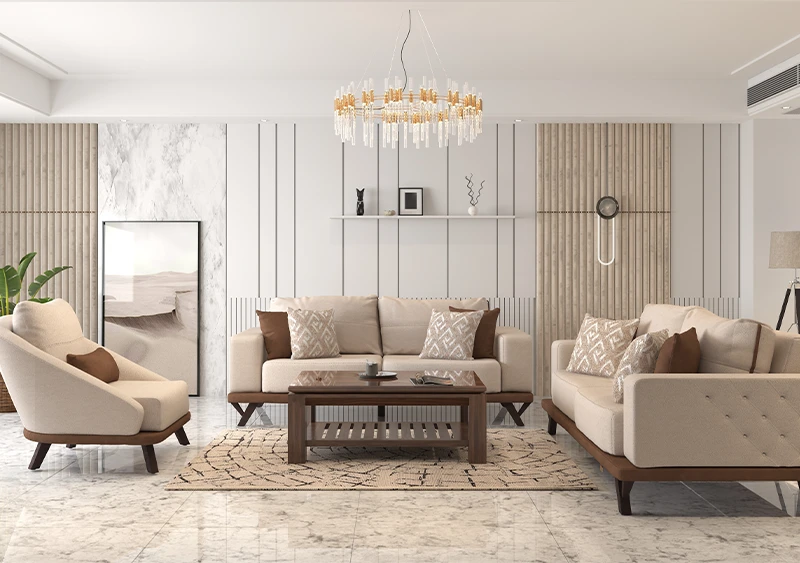Deliver Precision and Satisfaction with 3D Furniture Modeling
Turning “Almost Perfect” Designs into Client Favorites with 3D Modeling

5 MIN READ
December 12, 2024

Written By
Sasikumar Janakiraman
For businesses, this means smoother communication, reduced back-and-forth, and more satisfied clients. This blog discusses the impact of 3D furniture modeling in resolving common pain points and elevating client satisfaction in the furniture industry.
What Are 3D Furniture Modeling Services?
3D Furniture Modeling Services involve creating digital, three-dimensional representations of furniture designs. These models showcase intricate details, textures, and dimensions, providing a realistic view of how a product will look and function before it’s physically manufactured.
Businesses in the furniture industry, such as manufacturers, retailers, and designers, use these services to visualize concepts and optimize designs for production or marketing.
7 Key Benefits for B2B Clients
3D furniture modeling services offer numerous advantages for B2B businesses, helping streamline processes, enhance communication, and meet client expectations efficiently. Here’s a closer look at the top benefits:

-
1. Accurate Product Visualization
- B2B clients require clarity before making investments.
- 3D furniture models provide lifelike visuals that reflect every detail of the design, ensuring there’s no guesswork.
- These models showcase materials, textures, and dimensions, giving clients a complete understanding of the product.
-
2. Faster Design Approvals
- Traditional methods often involve delays due to unclear sketches or physical prototypes.
- With 3D models, stakeholders can view and approve designs more quickly.
- The realistic nature of these models eliminates confusion and accelerates decision-making.
-
3. Cost-Effective Prototyping
- Physical prototypes can be expensive and time-consuming to produce.
- 3D modeling eliminates the need for multiple iterations by allowing businesses to test and refine designs digitally.
- This reduces costs while ensuring the final product meets exact specifications.
-
4. Seamless Customization
- Clients often request changes during the design phase.
- 3D modeling makes these updates quick and easy, without the hassle of reworking physical models.
- The flexibility ensures the final product aligns perfectly with client needs.
-
5. Enhanced Marketing Materials
- Photorealistic 3D models are perfect for creating catalogs, websites, and promotional content.
- These visuals capture the attention of potential buyers, showcasing furniture in different settings and styles, which helps drive sales.
-
6. Improved Communication
- Miscommunication can lead to errors and delays in B2B transactions.
- 3D furniture models act as a clear point of reference, ensuring all parties (designers, manufacturers, and clients) are on the same page throughout the process.
-
7. Reduced Production Errors
- 3D modeling minimizes the risk of mistakes during manufacturing by providing precise, detailed representations.
- This ensures that the final product matches the original concept, saving time and resources.
Team Up with the Globally Recognized 3D Studio for Exceptional 3D Furniture Models!
10 Best Practices to Improve Client Satisfaction
In B2B relationships, client satisfaction is more than just delivering a service; it’s about building trust, ensuring efficiency, and driving long-term success. Here are 10 practical strategies to enhance satisfaction:
-
1. Prioritize Clear Onboarding Processes
Begin projects with comprehensive discussions to align on goals, timelines, and deliverables. An organized onboarding process lays the foundation for smooth execution.
-
2. Maintain Consistent Communication
Regular updates (weekly reports or milestone check-ins) ensure transparency and keep clients informed about project progress. Proactive communication prevents surprises and builds trust.
-
3. Deliver Tailored Solutions
Understand the specific needs of each client. Customizing services to align with their goals demonstrates commitment and increases satisfaction.
-
4. Incorporate Feedback at Every Stage
Create opportunities for clients to provide input during critical project phases. Acting on feedback promptly showcases adaptability and commitment to their vision.
-
5. Focus on Quality and Precision
Accuracy and high-quality outputs are non-negotiable. Invest in the right tools, such as 3D furniture modeling software, to meet exact specifications and exceed expectations.
-
6. Emphasize Timely Delivery
Stick to agreed deadlines. Timely delivery of projects is essential for maintaining professionalism and credibility in B2B engagements.
-
7. Build a Collaborative Workflow
Encourage involvement by making clients a part of the decision-making process. This fosters a sense of ownership and strengthens the relationship.
-
8. Provide Post-Delivery Support
Client satisfaction doesn’t end with project completion. Offer ongoing assistance, address queries, and provide insights for maximizing the delivered solutions.
-
9. Resolve Issues Proactively
Anticipate challenges and address them before they escalate. Being proactive not only prevents delays but also reassures clients of your problem-solving capabilities.
-
10. Measure and Improve Regularly
Seek feedback after each project to identify areas for improvement. Regularly evaluate processes to enhance efficiency and elevate the client experience.
How to Evaluate and Choose the Right Service Provider
Here's a systematic approach to evaluate and select the best provider for your business needs:
- Review their portfolio to ensure quality and alignment with your requirements.
- Check industry-specific experience for better understanding and execution.
- Verify use of advanced tools like Blender or Autodesk 3ds Max.
- Ensure clear communication for timely updates and smooth collaboration.
- Read client reviews to assess reliability and quality of service.
- Discuss deadlines to ensure timely delivery without compromising quality.
- Request a small test project to evaluate their workflow and standards.
- Understand pricing and terms to avoid hidden costs and misunderstandings.
- Confirm post-project support for revisions and technical assistance.
- Assess scalability to handle varying project sizes and demands effectively.
In Conclusion
3D furniture modeling makes it easier for businesses to meet client needs with accurate, detailed designs and faster approvals. It helps avoid costly mistakes, improves communication, and ensures projects run smoothly from start to finish.
By working with the right service provider and focusing on quality and clear communication, businesses can keep their clients happy and build stronger relationships. It’s a smart way to stay ahead and grow in a competitive market.
About the writer :
Sasikumar Janakiraman, as the Creative Director at Zealous Services, brings a unique mix of creativity and technical ... skill. He’s passionate about 2D and 3D design, leading teams to create stunning 3D models and visualizations. Sasikumar loves working closely with clients, making sure their ideas come to life in the best possible way. His goal? To make design feel simple and exciting.
Read MoreFrequently Asked Questions (FAQ)
What industries can benefit from 3D furniture modeling services?
3D furniture modeling services are ideal for industries like furniture manufacturing, interior design, architecture, e-commerce, and marketing. These industries rely on accurate and visually appealing models to streamline production, showcase products, and improve client presentations.
Can 3D furniture modeling help with custom furniture designs?
Yes, 3D modeling is highly effective for custom furniture. It allows businesses to visualize unique designs, make adjustments in real-time, and ensure client requirements are met before production begins, reducing errors and costs.
How do 3D furniture models improve e-commerce sales?
Photorealistic 3D models enhance online product displays, providing customers with detailed views of furniture pieces from all angles. This boosts buyer confidence and reduces return rates by offering a realistic understanding of the product.
What factors affect the cost of 3D furniture modeling services?
The cost depends on factors like design complexity, level of detail, number of pieces, and rendering quality. Custom designs or intricate textures may also increase the pricing. Discussing needs with the provider helps in budgeting effectively.
Is 3D furniture modeling eco-friendly compared to traditional prototyping?
Yes, it eliminates the need for physical prototypes, saving resources like wood, fabric, and energy. By relying on digital models, businesses can minimize waste and contribute to sustainable practices.